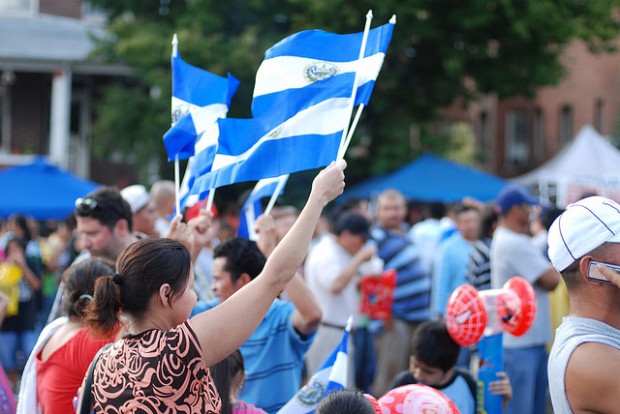Why D.C.’s Latino Population is Up When It’s Black Population is Down

Cameron Nordholm / Flickr
A woman waves the Salvadoran flag during Fiesta DC in Mount Pleasant, one of D.C.'s longtime Latino centers.
Columbia Heights and Mount Pleasant, traditionally the center of the D.C.’s Latino community, are much different places now than they were 20 years ago. Big box stores sit upon formerly vacant lots. Pupuserias now have vegan cafes as neighbors. House values have exploded. Ward 1, where these neighborhoods are located, has lost more than 2,000 Latinos over the past decade.
Travel a few blocks south and you see a similar transformation. The U Street area, formerly “Black Broadway,” was 77 percent black; it’s now only 15 percent black. Many longtime residents who had bought homes at modest prices have sold them for large sums. Others were priced out by rising rents. Luxury high-rise condo buildings have sprouted up.
But while the number of African Americans throughout D.C. is declining — by 11 percent over the past decade –the number of Latinos actually increased, by about 21 percent. This growth happened despite the fact that rapidly increasing housing prices have particularly affected longtime Latino neighborhoods, according to the District’s 2009 State of Latinos report.
So why is D.C.’s Latino community growing while it’s black community shrinks?
Migration and babies, according to Joy Phillips of the D.C. Office of Planning.
Between 1997 and 2007, Latino births increased by 130 percent, while black births declined by 13.5 percent [PDF]. But the biggest jump in the city’s Latino population wasn’t among little children (0 to 4 year olds); it was among adults between 55 and 64 years of age, indicating migration into the District has a lot to do with the growing Latino population, according to Phillips.
“Gentrification may be having an impact on Latinos in some areas of the city,” Phillips writes in an email. “However, Hispanics have increased in every other ward of the city.”
Ward 4, which includes Petworth, Takoma and Brightwood, experienced the city’s biggest increase in Latino residents — 4,923 people — “where it may be argued housing is cheaper,” Phillips writes. Even small Latino communities in Southeast and Northeast, where few have ever lived, are growing; Ward 7′s Hispanic population grew by 150 percent to about 1,500 residents.
Meanwhile, more black residents are leaving D.C. than are moving into the District. Over the past decade, the number of black residents has dropped in every ward of the city except in Ward 8, where the black population only grew slightly.
So even as black residents are leaving D.C. — whether because of gentrification or looking to the suburbs for greener pastures – the city is still attracting new Latino residents. It’s just that now, they are choosing to settle in Petworth or Brightwood over pricier Columbia Heights.
-
http://pulse.yahoo.com/_P7XW7N5RYOJI33HHPL65GSPE5Q K





